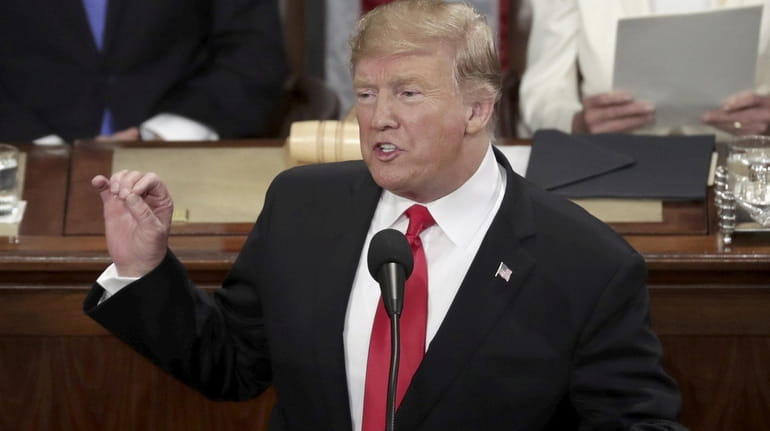State of the Trump agenda is shaky at best after a well-hyped address

President Donald Trump gives his second State of the Union address Tuesday on the House floor. Credit: Getty Images/Chip Somodevilla
Chances of success appear weak for much if not most of the agenda President Donald Trump outlined in his State of the Union speech last week.
For starters, the grand rebuilding of crumbling infrastructure that he keeps promising resembles a flickering mirage rather than a program.
“I am eager to work with you on legislation to deliver new and important infrastructure investment, including investments in the cutting-edge industries of the future,” he told Congress last Tuesday. “This is a necessity.”
Details were even sparser than in his earlier reveal of a $1.5 trillion infrastructure plan. Last time, he talked about $200 billion in federal funds to spur states, localities and companies to invest the rest in roads, bridges and airports.
In 2017 and 2018 Trump, the Senate and the GOP-run House put tax cuts and other bills ahead of the nation’s physical plant. With the federal deficit ballooning, public-works financing seems especially forbidding.
As budget requests go, Trump may wish to call his dearly-sought border-wall-fence-barrier project his whole infrastructure program and leave it at that.
It is difficult to divine just what else his State of the Union message might inspire Congress to act on.
He demanded that Congress approve legislation to “prohibit the late-term abortion of children who can feel pain in the mother’s womb.”
Do Trump and aides remotely expect a sharply divided Congress to agree and act on any kind of abortion legislation before the conservative Supreme Court acts on Roe v. Wade? Don’t bet on it.
The best odds belong to relatively modest bipartisan proposals any president might seek, such as Trump's well-received request for $500 million over 10 years to fund childhood cancer research.
After the 2016 election, both GOP houses approved legislation boosting overall federal cancer research, including $1.8 billion for then-Vice President Joe Biden’s “cancer moonshot” initiative.
One day after the State of the Union, Trump rather passively told regional reporters who asked about tax deductions that he was “open to talking about” revisions to the new state and local tax cap. Signed by Trump, the cap limits to $10,000 the amount of these levies, including property taxes, that taxpayers can deduct on federal returns.
A revision is highly unlikely. Senate Finance Committee Chairman Chuck Grassley (R-Iowa) said flatly last week his office will not alter the measure. For that matter, Trump's pre-election talk of a GOP "plan" for a new "very major tax cut" for middle-income earners proved to be about nothing at all.
The president's "border wall" push, which forced the recent 35-day government shutdown, looked no more or less viable after the annual address to Congress than before.
If he aimed to convert nonbelievers with the power of facts, that didn't happen. Instead he repeated an appealing but false story about how a barrier made El Paso safe from crime. His assertion that women and girls are smuggled by the “thousands” across remote areas of the border also goes unsupported.
Trump called it a "major priority" to lower health care and prescription costs and "protect patients with pre-existing conditions."
How both parties in Congress might agree to do that remains elusive.

